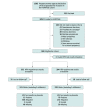Association Between Human Papillomavirus Infection Among Pregnant Women and Preterm Birth
- PMID: 34524433
- PMCID: PMC8444026
- DOI: 10.1001/jamanetworkopen.2021.25308
Association Between Human Papillomavirus Infection Among Pregnant Women and Preterm Birth
Abstract
Importance: Preterm birth remains a leading cause of perinatal mortality and lifelong morbidity worldwide. The cause of most preterm births is unknown, although several infectious processes have been implicated.
Objective: To assess whether human papillomavirus (HPV) infection, a frequent infection among women of childbearing age, is associated with preterm birth.
Design, setting, and participants: The prospective HERITAGE cohort study was conducted at 3 academic hospitals in Montreal, Québec, Canada, among 899 pregnant women recruited between November 8, 2010, and October 16, 2016. Follow-up was completed on June 15, 2017. Statistical analysis was conducted from February 6, 2020, to January 21, 2021.
Exposures: Vaginal HPV DNA detection in the first and third trimesters of pregnancy and placental HPV infection.
Main outcomes and measures: The main outcome was preterm birth (defined as a live birth or stillbirth between 20 weeks and 0 days and 36 weeks and 6 days of gestation). The association between HPV DNA detection and preterm birth was measured using logistic regression. Odds ratios (ORs) and 95% CIs were adjusted by inverse probability of treatment weights of the propensity score.
Results: The study included 899 women (mean [SD] age, 31.3 [4.6] years [range, 19-47 years]) with singleton pregnancies. A total of 378 women (42.0%) had HPV DNA detected in vaginal samples collected during the first trimester, and it was detected in 91 of 819 placentas (11.1%) at delivery. Fifty-five participants experienced preterm birth (38 spontaneous and 17 medically indicated). Persistent vaginal HPV-16/18 detection was significantly associated with all preterm births (adjusted OR [aOR], 3.72; 95% CI, 1.47-9.39) and spontaneous preterm births (aOR, 3.32; 95% CI, 1.13-9.80), as was placental HPV infection (all preterm births: aOR, 2.53; 95% CI, 1.06-6.03; spontaneous preterm births: aOR, 2.92; 95% CI, 1.09-7.81). Results were similar when restricting the analysis to participants without a history of cervical intraepithelial neoplasia treatment.
Conclusions and relevance: The study's results suggest that persistent HPV-16/18 infection is associated with an increased risk of preterm birth, independent of cervical treatment. Future studies should investigate the association of HPV vaccination and vaccination programs with the risk of preterm birth.
Conflict of interest statement
Figures


References
Publication types
MeSH terms
Substances
LinkOut - more resources
Full Text Sources
Other Literature Sources
Medical

